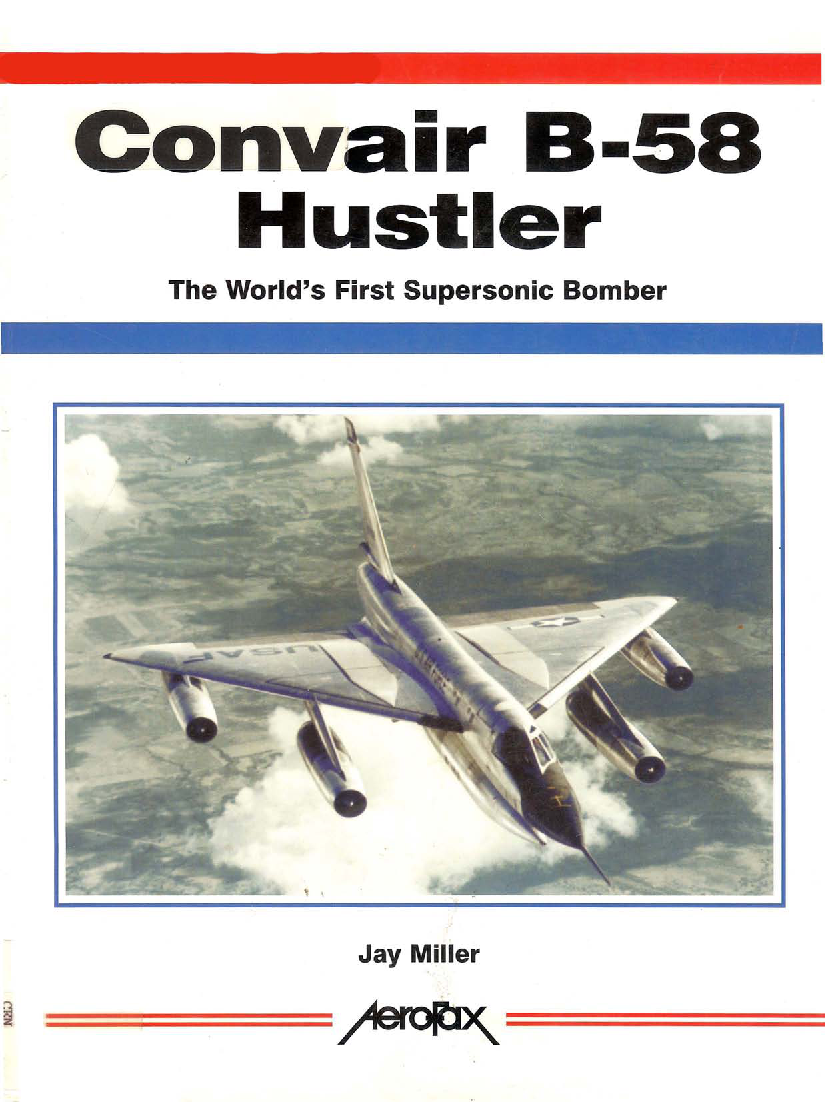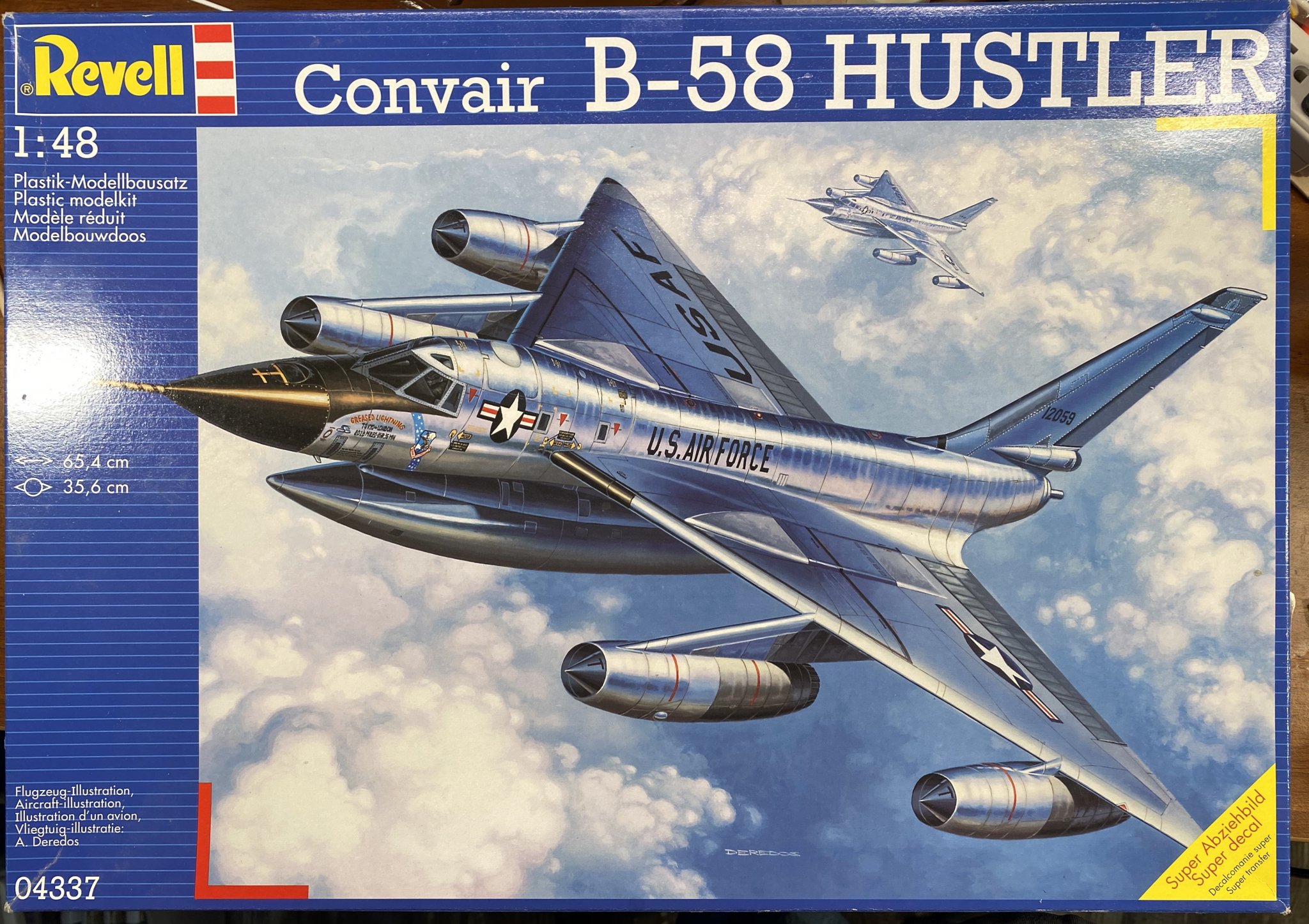Convair B 58 - The B-58 Hustler, designed and manufactured by the American aircraft manufacturer Convair, was the first operational bomber capable of flying at Mach 2.
The B-58 was developed in the 1950s for the United States Air Force (USAF) Strategic Air Command (SAC). To achieve the desired high speeds, Convair chose a delta wing design used by modern fighters such as the Convair F-102. The bomber was powered by four Geral Electric J79 engines located in the lower pods. It did not have a bomb shelter. it carried one nuclear weapon plus fuel in a bomb assembly/fuel pod below. Four external hardpoints were later added, enabling it to carry up to five weapons.
Convair B 58

The B-58 entered service in March 1960, flying for a decade with two SAC bomb wings, the 43rd Bombardier Wing and the 305th Bombardier Wing.
Convair B 58a Hustler (55 0663) Aircraft Pictures & Photos
It was considered difficult to fly and imposed a great strain on its crew of three. Designed to replace the subsonic Boeing B-47 Stratojet strategic bomber, the B-58 became famous for its sonic boom heard by audiences on the ground as it passed in hypersonic flight.
The B-58 was designed to fly at high altitudes and supersonic speeds to avoid Soviet interception, but with the Soviet introduction of high-altitude surface-to-air missiles, the B-58 was forced into a low-level role. which severely limited its scope and strategic value. It was never used to deliver conventional bombs. The B-58 was more difficult to operate than other bombers, such as the Boeing B-52 Stratofortress, and required more aerial refueling. The B-58 bomber also suffered a high rate of accident losses. These factors led to a relatively short operational career of t years. The B-58 was succeeded in its role by the smaller swing FB-111A.
The B-58 was the brainchild of the Generalized Bomber Study (GEBO II), launched in February 1949 by the Air Research and Development Command (ARDC) at Wright-Patterson AFB, Ohio, to develop a supersonic, long-range, piloted bomber. Airplane. The ARDC sought the best quantitative data available, prompting the industry to develop its own solutions to meet the stated goal.
Work on the proposed bomber design was to begin less than two years after hypersonic flight was achieved.
B 58 Production Line At The Convair Factory, Fort Worth
According to aviation authors Bill Johnston and Peter Gilchrist, while some militaries were interested in the potential use of supersonic bombers, others had doubts about the propulsion systems and materials required for supersonic operations, as well as their higher fuel consumption compared to their subsonic counterparts. colleagues.
Despite the doubts, several contractors submitted bids for GEBO II, which was seen as an influential step toward a development contract. These companies included Boeing, Convair, Curtiss, Douglas & Martin, and North American Airlines. Most of the surveys were simple and relatively unpretentious.
Convair, which built the XF-92A and other delta fighters, evaluated the swept and semi-delta configurations and settled on a delta wing that offered good internal volume for support and fuel systems. They also provide reduced wing loading for the airframe size, allowing supersonic flight in the mid-stratosphere at altitudes of 50,000 to 70,000 ft (15,000 to 21,000 m).

Most of the configurations studied combined a delta wing with a relatively larger fuselage that accommodated a crew of two and was supported by a pair of aircraft.
Convair B 58 Hustler Large Mahogany Model
Convair's offering, codenamed the FZP-110, was a radical two-seat delta-wing bomber powered by three Geralt Electric J53 turbofans. Performance ratings included 1,000 mph (1,600 km/h) and 3,000 miles (4,800 km).
A key design feature was that consumables, both weapons and most of the fuel, were stored in a large external compartment, resulting in a smaller fuselage. In January 1951, Convair submitted a bid for the FZP-110, which was received later than other competing bids.
In December 1951, a revised FZP-016 proposal was submitted, which deleted the third tail axle, added the remaining two thrusters, and added a third crew member to operate the defense systems.
The Air Force has selected Boeing's MX-1712 and Convair MX-1626 design studies to proceed to Phase I study. During this period, Convair took advantage of direct developments from General Electric and replaced the two large J53s with four smaller J79s optimized for supersonic flight.
Aerofax: Convair B 58 Hustler: The World's First Supersonic Bomber: Amazon.co.uk: Miller, Jay: 9781857800586: Books
The direct area rule was also applied to the design, resulting in an aerodynamic design and an older fuselage. After it was revised, Convair redesigned its relaunched MX-1964.
According to Gunston and Gilchrist, Boeing's performance was considered equally good, but their separate contract to manufacture the Boeing B-52 Stratofortress undoubtedly inflated that competition.
In December 1952, Convair selected the SAB-51 (Supersonic Aircraft Bomber) and SAR-51 (Supersonic Reconnaissance Aircraft) to meet the first General Operating Requirements (GOR) for supersonic bombers. In February 1953, the Air Force awarded a contract for the Convair design, which was designated the B-58 on 10 December 1952.

The B-58 program, unlike previous warplanes, is now recognized as the first contract weapon system.
Convair B 58a Archives
Under this arrangement, Convair acted as the general contractor, responsible for all elements of the project, not just the aircraft. Convair was required to develop or subcontract everything related to the operation of the aircraft, from solutions to training manuals, spare parts and software, more than one million units.
Initially, the contract was modified to build a pair of XB-58 prototypes, 11 pre-production YB-58A aircraft, and 31 mission pods, including a free-fall bomb pod, a rocket-guided bomb pod, a reconnaissance pod, and an electronic survey.
The program was implemented under strict security measures. before the software was released, no unauthorized person knew its basic form or configuration.
On November 11, 1956, the flight of the maid took place. The prototype exceeded Mach 1 for the first time on December 30 of that year.
The B 58 Mach 2 Bomber Was Sexy, But Hard To Fly. Here's Why The Hustler Was One Of The Most Controversial Designs In History Of Aviation.
A total of 116 B-58s were produced: 30 test aircraft and 86 production B-58As. Most of the experimental aircraft were later upgraded to operational standards. Eight TB-58A trainers were equipped.
Most of them will never get off the board, being ordered before the decision to terminate multiple contracts. The B-58B, B-58C, B-58D, and B-58E variants were discontinued before production aircraft were completed. In the late 1960s, some modifications were developed and introduced into the existing fleet, such as larger bomb racks (known as multi-weapon capability) and additional engines.
The Convair B-58 Hustler was a high-speed strategic bomber that could routinely reach Mach 2. It incorporated a large delta wing with a 60° sweep and was powered by an arrangement of four Geralt Electric J79-GE-1 turbofans. Although its massive wing carried a relatively low wing load, it was well suited for low-altitude, high-speed flight. To protect against heat build-up while cruising at Mach 2, the crew compartment, wheel wells, and electronics pod were pressurized and ventilated. The B-58 was one of the first mass applications of aluminum cell panels, bonding outer and inner aluminum skins to an aluminum or fiberglass cell.

The fuselage itself accounted for 13.8 carats of the aircraft's gross weight, an exceptionally low figure for the era, while the wing was also extremely thin. Several key features of the engine, including the tailstock and intake, were unlike existing aircraft, taken from aerodynamic instructions.
Italeri 1/72 Convair B 58 Hustler Usaf Model Kit No. 142
Specifically, the intakes used movable tapered propellers that are fully aft on the ground and at low speed to maximize air intake, and pushed forward in high-speed flight to minimize annular gap. This engine was controlled automatically, but a lot of noise and asymmetric knock would be emitted on the eve of a single inlet failure.
The B-58 was operated by a crew of three: a pilot (Aircraft Commander or "AC"), a radar navigator/bombardier (Navigator or "Nav"), and a Defense Systems Operator (DSO).
They were seated in separate cockpits. The pilot's cockpit, equipped with very deep windows, was mainly considered a diversion for a large multi-role aircraft.
The defense systems operator was fitted with a complex array of divergence systems, described by Gunston and Gilchrist as the most sophisticated of any aircraft of the era. The crew compartment, despite being about half the internal volume of the fuselage, was generally considered cramped and claustrophobic.
Aircraft Photo Of 61 2080 / 12080
Later versions of the B-58 equipped each crew member with a new ejection pod that could be ejected at speeds up to Mach 2 at 70,000 ft (21,000 m). The seat and joystick mold will be sealed with an attached oxygen cylinder, allowing the pilot to continue flying "up" and be ready for immediate exit. The capsule was floating. The conch can be operated by a crew member and used as a life raft.
It was qualified for use in 1963, and a bear became the first animal to survive a supersonic blast.
The electronic controls were ambitious and advanced for the day. The Navigator and DSO cockpits contained wraparound panels with warning lights and buttons, and voice messages and automatic warnings from the tape system could be heard through the helmet assemblies. Search at noon

Convair b 36 bomber, convair b 36, convair b 60, convair b-58, convair b-58 hustler, convair b 36j peacemaker, convair b 32, b-58, convair b 36 peacemaker model, convair b 36j, convair b-36 peacemaker, b 58
0 Comments